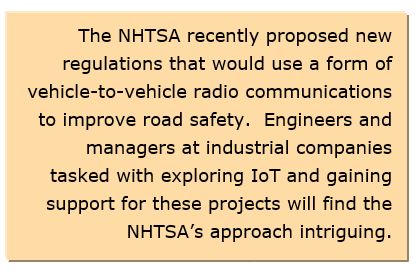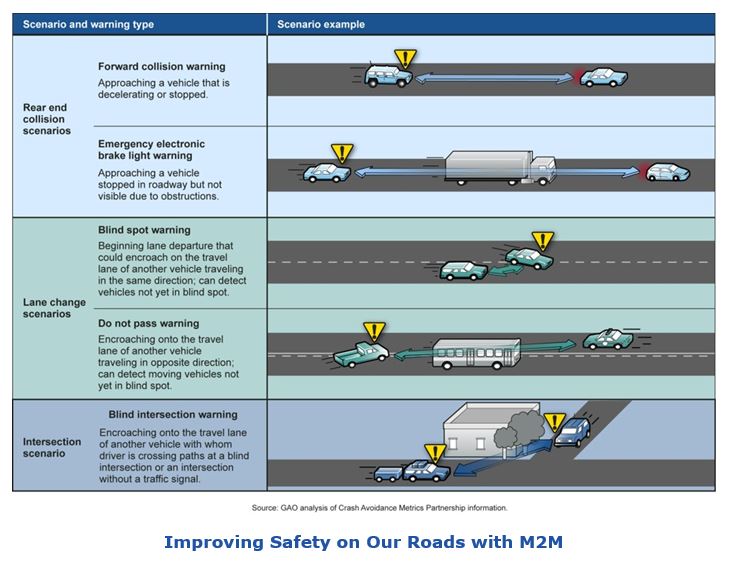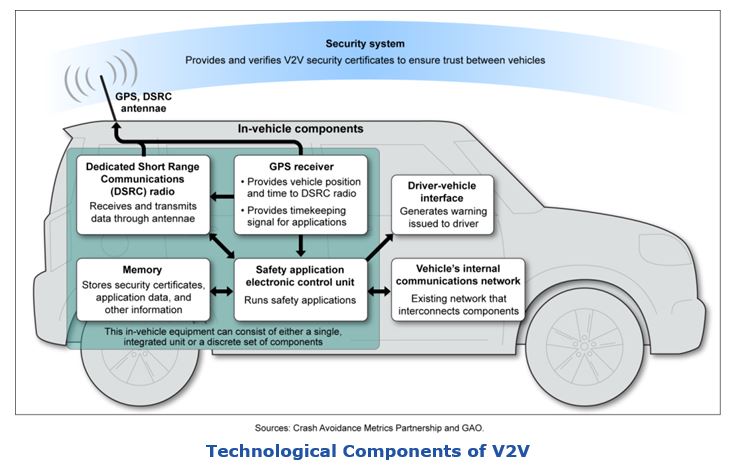

The US National Highway Traffic Safety Administration (NHTSA) recently proposed new safety regulations that have received very little coverage in the Autonomous Vehicle Market. These regulations would use a new machine-to-machine (M2M) technology 
For followers of IoT developments, this report provides an interesting new use case with potentially significant impacts. These include increasing safety, speeding the viability of autonomous vehicles, and SmartCity implications. From a supply chain perspective, these regulations provide some additional insights into when autonomous trucks might be able to begin delivering freight without requiring on-board drivers.
The US National Highway Traffic Safety Administration (NHTSA) proposed new safety regulations on December 13, 2016. These regulations would use a new technology – vehicle-to-vehicle (V2V) radio communications – that would allow vehicles to automatically send relevant vehicle sensor data to other vehicles to alert drivers to potential crash situations.
Advanced crash avoidance technologies already in use employ on-board sensor technologies - such as vehicle camera systems, RADAR, and LIDAR - to monitor a vehicle’s surroundings. That sensor data is used to warn the driver of impending danger so he or she can take appropriate action to avoid or mitigate a crash. Examples of the alerts include forward collision warnings, blind spot warnings, and lane change warnings. These sensors can also be used for driver assist by allowing a vehicle to automatically apply braking in a potential collision scenario.

The NHTSA is proposing that Basic Safety Message data should be shared with other nearby vehicles so that other types of potential accidents can be prevented. The Basic Safety Message will use vehicle-to-vehicle technology to communicate data on the vehicle’s speed, heading, brake status, and other vehicle information to surrounding vehicles and receive the same information from them.
Sharing and processing these data will help prevent the types of accidents current technologies help prevent, but also some that they don’t address; such as a vehicle about to turn in front of yours at an intersection. The NHTSA also argues that the current sensor-based technologies have limitations in terms of sensor range and inability to fully cope with sensor obstructions that future vehicle-to-vehicle systems will overcome.
The NHTSA calls existing technologies “vehicle-resident systems,” and believes that the combination of vehicle-resident systems and new “communication-based systems” will increase preventive capabilities in a complementary manner.
Proposed regulatory agency rules must include a cost/benefit analysis. The NHSTA foresees savings much larger than costs; 30 years out from when the mandate takes effect it is projecting $2.2 billion to $5 billion in costs ($135 to $300 per vehicle), but savings of $53 to $71 billion based on reduced costs associated with crashes.

Governmental agencies proposed rule makings progress incrementally. This first phase would require this technology only for new light-duty vehicles. Light-duty vehicles have a gross vehicle weight rating of 10,000 pounds (4,536 kilograms) or less.
And the proposal, if not slowed by lawsuits, foresees a phased implementation with a final ruling in 2019. But almost all regulatory bodies proposing new regulations do end up defending the regulations in court, slowing the final rule making by at least a year and often multiple years. In this case, there are almost certain to be lawsuits and delays. Once the final ruling is in place, vehicle manufacturers will have a three-year phase in period to comply with the current regulation, which proposes that 50 percent, 75 percent, and 100 percent of vehicles, respectively, be covered during the phase in. Regulatory bodies, when they receive pushback, often do give companies a longer period to comply.
Further, the full benefits of V2B won’t be present until all vehicles are subject to the same regulations. The NHTSA will almost certainly propose similar requirements for other classes of vehicles, but the timing of these requirements is unknown.
Finally, a new administration focused on saving working class jobs may decide that the 2.5 million trucking jobs that could eventually be at risk based on this proposal warrant slowing down or even cancelling these initiatives.
In putting forward this proposal, the NHSTA recognizes that potential objections to this proposal include cybersecurity, health and safety issues associated with the radio transmissions, and the importance of developing globally harmonized standards. These are issues that industrial companies contemplating Industrial Internet of Things (IIoT) or M2M projects also need to understand.
Looking further ahead, the NHSTA also wants to have vehicles communicate with transportation infrastructure such as traffic lights, stop signs, and work zones to reduce congestion and improve safety. Technology companies such as IBM have talked about one of the advantages of IIoT being the ability to develop Smart Cities; these developments are certainly in line with that thinking.
If we assume improving the safety of autonomous vehicles is a key obstacle that must be overcome, and that V2V is a core technology to improving safety, and we look at how long it will take to fully roll out these regulations, it is safe to infer that we will not see autonomous trucks carrying freight for at least a decade.
Engineers and managers at industrial companies tasked with exploring IoT may find the NHTSA Notice of Proposed Rulemaking an interesting read. Its focus on an innovative new application for M2M, the thoroughness with which they examine costs and benefits, and the way the report addresses potential objections to the rulemaking and overcoming those objections, provide a good template for gaining support for IoT projects.
If you would like to buy this report or obtain information about how to become a client, please Contact Us
Keywords: M2M, Autonomous Vehicles, Safety Regulations, ARC Advisory Group.

